Significances of Physical Activity Among old People with Alzheimer's Disease Assignment 2022
VerifiedAdded on 2022/10/11
|11
|3056
|9
Assignment
AI Summary
Contribute Materials
Your contribution can guide someone’s learning journey. Share your
documents today.
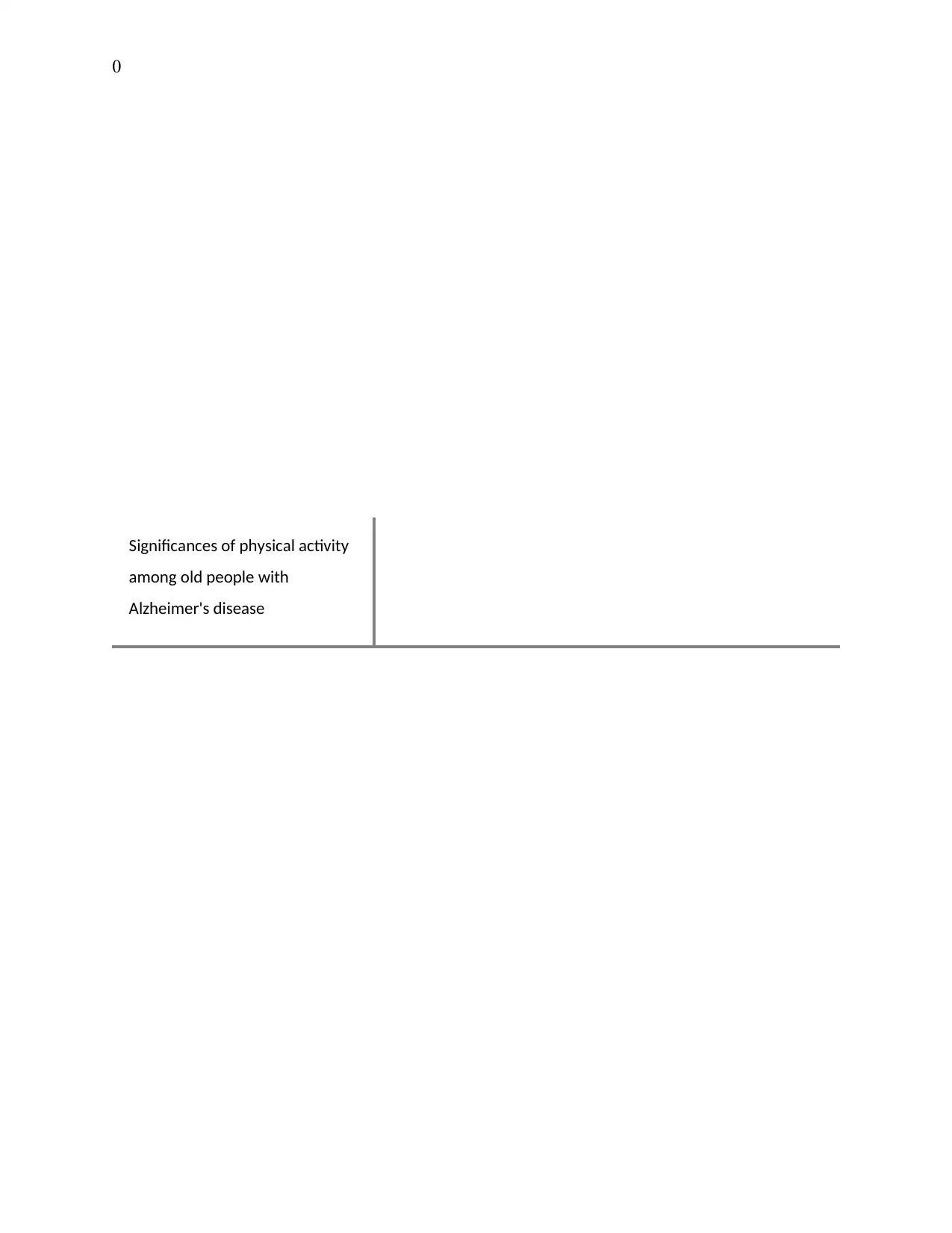
0
Significances of physical activity
among old people with
Alzheimer's disease
Significances of physical activity
among old people with
Alzheimer's disease
Secure Best Marks with AI Grader
Need help grading? Try our AI Grader for instant feedback on your assignments.
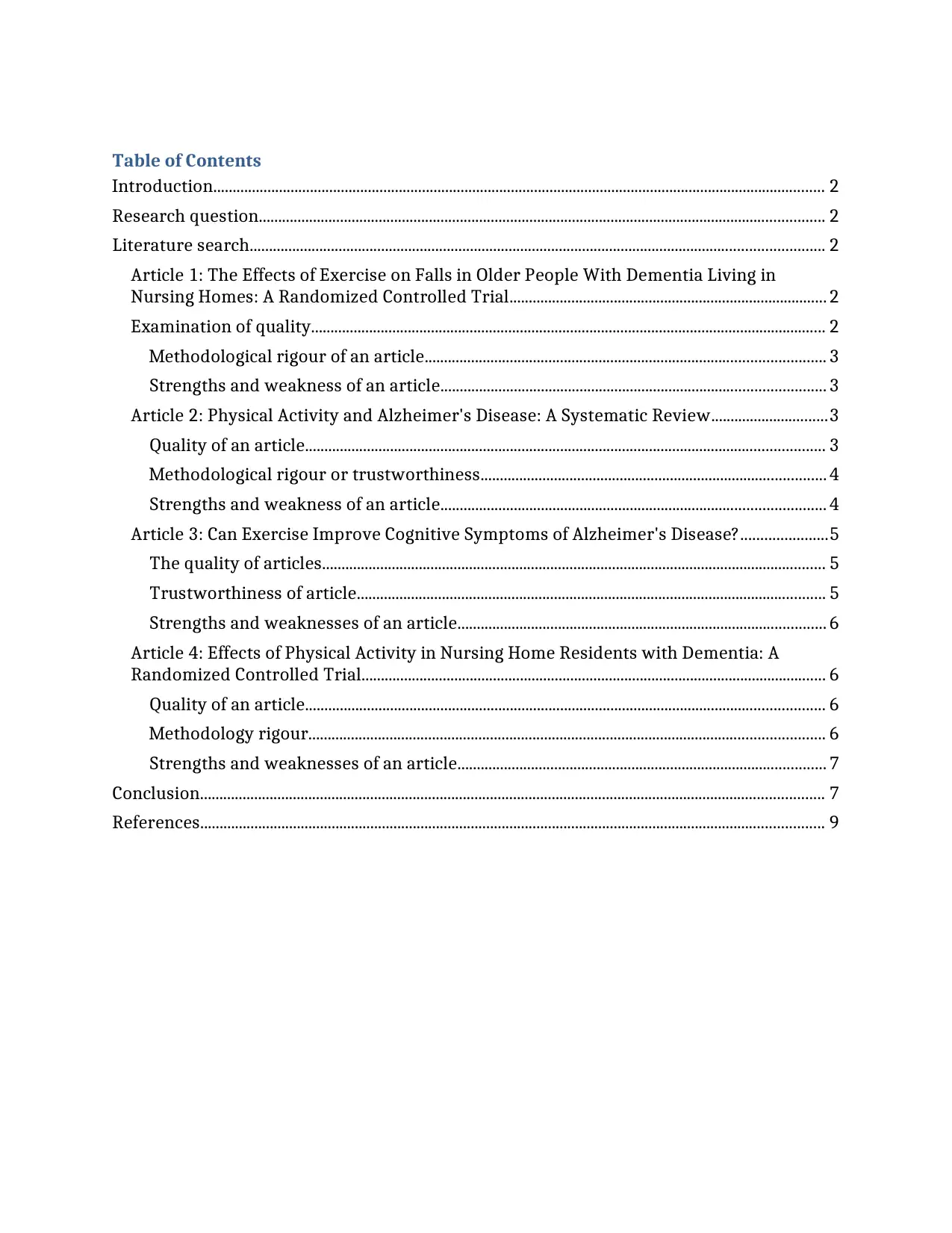
Table of Contents
Introduction.............................................................................................................................................................. 2
Research question.................................................................................................................................................. 2
Literature search.................................................................................................................................................... 2
Article 1: The Effects of Exercise on Falls in Older People With Dementia Living in
Nursing Homes: A Randomized Controlled Trial.................................................................................. 2
Examination of quality..................................................................................................................................... 2
Methodological rigour of an article....................................................................................................... 3
Strengths and weakness of an article................................................................................................... 3
Article 2: Physical Activity and Alzheimer's Disease: A Systematic Review..............................3
Quality of an article...................................................................................................................................... 3
Methodological rigour or trustworthiness......................................................................................... 4
Strengths and weakness of an article................................................................................................... 4
Article 3: Can Exercise Improve Cognitive Symptoms of Alzheimer's Disease?......................5
The quality of articles.................................................................................................................................. 5
Trustworthiness of article......................................................................................................................... 5
Strengths and weaknesses of an article............................................................................................... 6
Article 4: Effects of Physical Activity in Nursing Home Residents with Dementia: A
Randomized Controlled Trial........................................................................................................................ 6
Quality of an article...................................................................................................................................... 6
Methodology rigour..................................................................................................................................... 6
Strengths and weaknesses of an article............................................................................................... 7
Conclusion................................................................................................................................................................. 7
References................................................................................................................................................................. 9
Introduction.............................................................................................................................................................. 2
Research question.................................................................................................................................................. 2
Literature search.................................................................................................................................................... 2
Article 1: The Effects of Exercise on Falls in Older People With Dementia Living in
Nursing Homes: A Randomized Controlled Trial.................................................................................. 2
Examination of quality..................................................................................................................................... 2
Methodological rigour of an article....................................................................................................... 3
Strengths and weakness of an article................................................................................................... 3
Article 2: Physical Activity and Alzheimer's Disease: A Systematic Review..............................3
Quality of an article...................................................................................................................................... 3
Methodological rigour or trustworthiness......................................................................................... 4
Strengths and weakness of an article................................................................................................... 4
Article 3: Can Exercise Improve Cognitive Symptoms of Alzheimer's Disease?......................5
The quality of articles.................................................................................................................................. 5
Trustworthiness of article......................................................................................................................... 5
Strengths and weaknesses of an article............................................................................................... 6
Article 4: Effects of Physical Activity in Nursing Home Residents with Dementia: A
Randomized Controlled Trial........................................................................................................................ 6
Quality of an article...................................................................................................................................... 6
Methodology rigour..................................................................................................................................... 6
Strengths and weaknesses of an article............................................................................................... 7
Conclusion................................................................................................................................................................. 7
References................................................................................................................................................................. 9
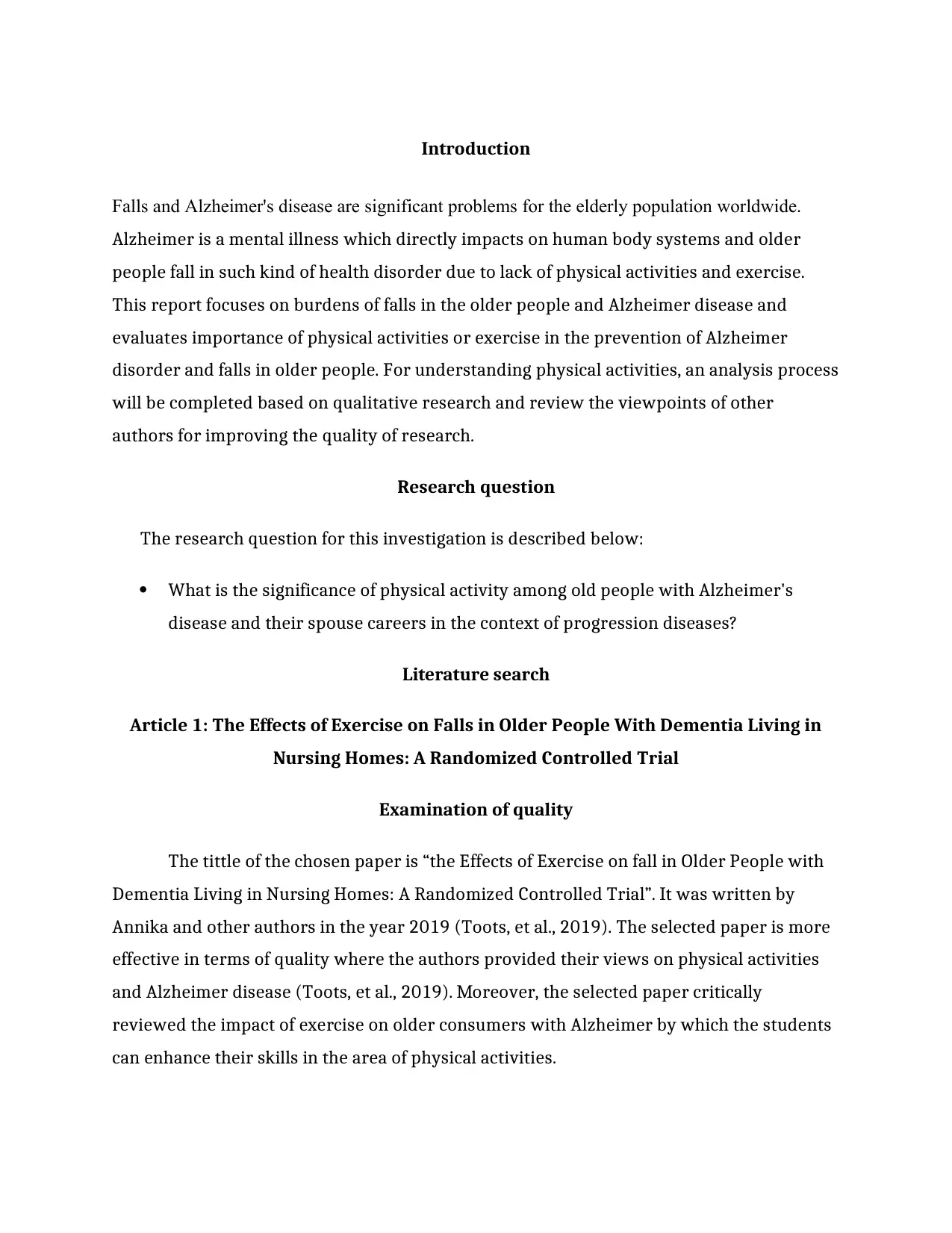
Introduction
Falls and Alzheimer's disease are significant problems for the elderly population worldwide.
Alzheimer is a mental illness which directly impacts on human body systems and older
people fall in such kind of health disorder due to lack of physical activities and exercise.
This report focuses on burdens of falls in the older people and Alzheimer disease and
evaluates importance of physical activities or exercise in the prevention of Alzheimer
disorder and falls in older people. For understanding physical activities, an analysis process
will be completed based on qualitative research and review the viewpoints of other
authors for improving the quality of research.
Research question
The research question for this investigation is described below:
What is the significance of physical activity among old people with Alzheimer's
disease and their spouse careers in the context of progression diseases?
Literature search
Article 1: The Effects of Exercise on Falls in Older People With Dementia Living in
Nursing Homes: A Randomized Controlled Trial
Examination of quality
The tittle of the chosen paper is “the Effects of Exercise on fall in Older People with
Dementia Living in Nursing Homes: A Randomized Controlled Trial”. It was written by
Annika and other authors in the year 2019 (Toots, et al., 2019). The selected paper is more
effective in terms of quality where the authors provided their views on physical activities
and Alzheimer disease (Toots, et al., 2019). Moreover, the selected paper critically
reviewed the impact of exercise on older consumers with Alzheimer by which the students
can enhance their skills in the area of physical activities.
Falls and Alzheimer's disease are significant problems for the elderly population worldwide.
Alzheimer is a mental illness which directly impacts on human body systems and older
people fall in such kind of health disorder due to lack of physical activities and exercise.
This report focuses on burdens of falls in the older people and Alzheimer disease and
evaluates importance of physical activities or exercise in the prevention of Alzheimer
disorder and falls in older people. For understanding physical activities, an analysis process
will be completed based on qualitative research and review the viewpoints of other
authors for improving the quality of research.
Research question
The research question for this investigation is described below:
What is the significance of physical activity among old people with Alzheimer's
disease and their spouse careers in the context of progression diseases?
Literature search
Article 1: The Effects of Exercise on Falls in Older People With Dementia Living in
Nursing Homes: A Randomized Controlled Trial
Examination of quality
The tittle of the chosen paper is “the Effects of Exercise on fall in Older People with
Dementia Living in Nursing Homes: A Randomized Controlled Trial”. It was written by
Annika and other authors in the year 2019 (Toots, et al., 2019). The selected paper is more
effective in terms of quality where the authors provided their views on physical activities
and Alzheimer disease (Toots, et al., 2019). Moreover, the selected paper critically
reviewed the impact of exercise on older consumers with Alzheimer by which the students
can enhance their skills in the area of physical activities.
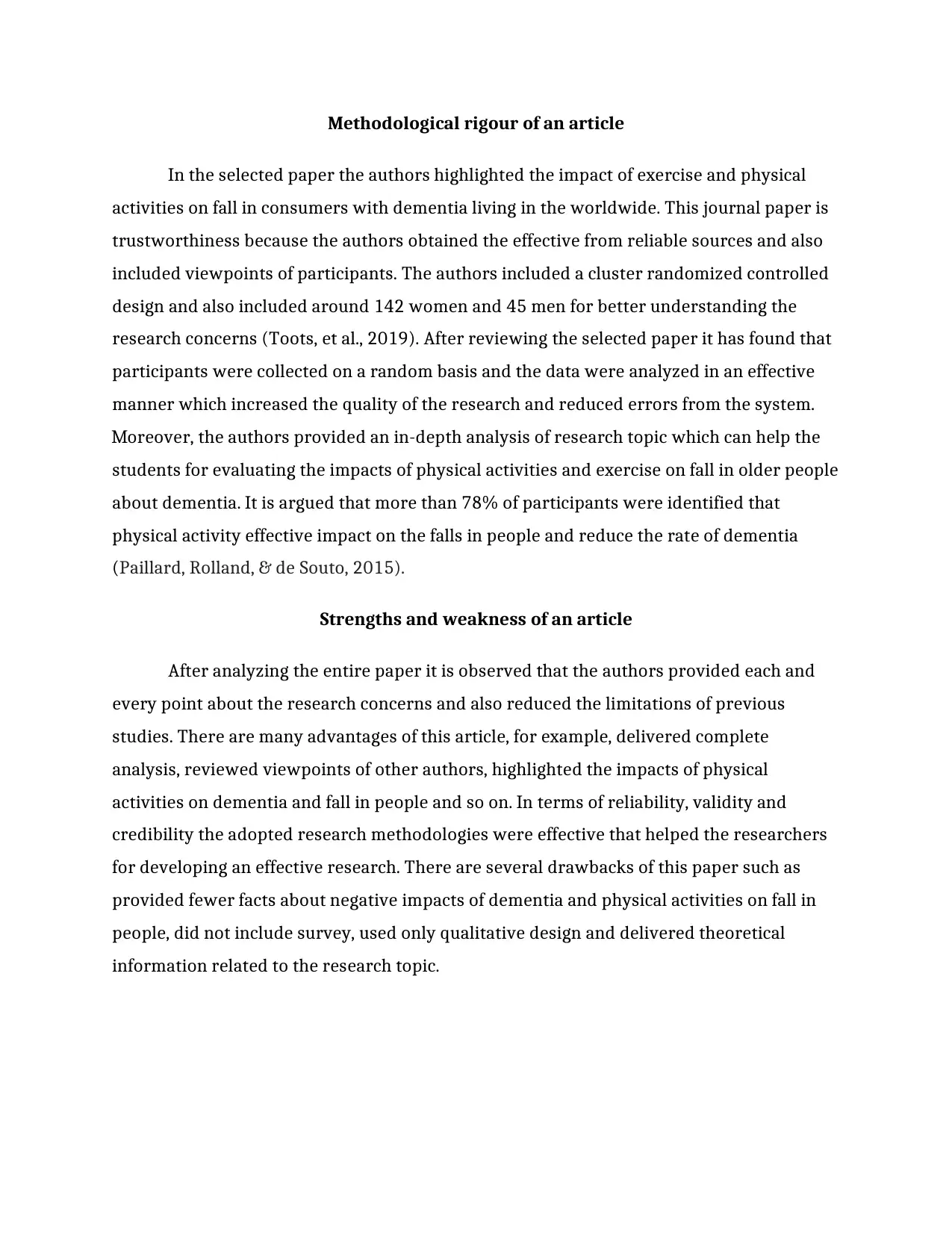
Methodological rigour of an article
In the selected paper the authors highlighted the impact of exercise and physical
activities on fall in consumers with dementia living in the worldwide. This journal paper is
trustworthiness because the authors obtained the effective from reliable sources and also
included viewpoints of participants. The authors included a cluster randomized controlled
design and also included around 142 women and 45 men for better understanding the
research concerns (Toots, et al., 2019). After reviewing the selected paper it has found that
participants were collected on a random basis and the data were analyzed in an effective
manner which increased the quality of the research and reduced errors from the system.
Moreover, the authors provided an in-depth analysis of research topic which can help the
students for evaluating the impacts of physical activities and exercise on fall in older people
about dementia. It is argued that more than 78% of participants were identified that
physical activity effective impact on the falls in people and reduce the rate of dementia
(Paillard, Rolland, & de Souto, 2015).
Strengths and weakness of an article
After analyzing the entire paper it is observed that the authors provided each and
every point about the research concerns and also reduced the limitations of previous
studies. There are many advantages of this article, for example, delivered complete
analysis, reviewed viewpoints of other authors, highlighted the impacts of physical
activities on dementia and fall in people and so on. In terms of reliability, validity and
credibility the adopted research methodologies were effective that helped the researchers
for developing an effective research. There are several drawbacks of this paper such as
provided fewer facts about negative impacts of dementia and physical activities on fall in
people, did not include survey, used only qualitative design and delivered theoretical
information related to the research topic.
In the selected paper the authors highlighted the impact of exercise and physical
activities on fall in consumers with dementia living in the worldwide. This journal paper is
trustworthiness because the authors obtained the effective from reliable sources and also
included viewpoints of participants. The authors included a cluster randomized controlled
design and also included around 142 women and 45 men for better understanding the
research concerns (Toots, et al., 2019). After reviewing the selected paper it has found that
participants were collected on a random basis and the data were analyzed in an effective
manner which increased the quality of the research and reduced errors from the system.
Moreover, the authors provided an in-depth analysis of research topic which can help the
students for evaluating the impacts of physical activities and exercise on fall in older people
about dementia. It is argued that more than 78% of participants were identified that
physical activity effective impact on the falls in people and reduce the rate of dementia
(Paillard, Rolland, & de Souto, 2015).
Strengths and weakness of an article
After analyzing the entire paper it is observed that the authors provided each and
every point about the research concerns and also reduced the limitations of previous
studies. There are many advantages of this article, for example, delivered complete
analysis, reviewed viewpoints of other authors, highlighted the impacts of physical
activities on dementia and fall in people and so on. In terms of reliability, validity and
credibility the adopted research methodologies were effective that helped the researchers
for developing an effective research. There are several drawbacks of this paper such as
provided fewer facts about negative impacts of dementia and physical activities on fall in
people, did not include survey, used only qualitative design and delivered theoretical
information related to the research topic.
Secure Best Marks with AI Grader
Need help grading? Try our AI Grader for instant feedback on your assignments.
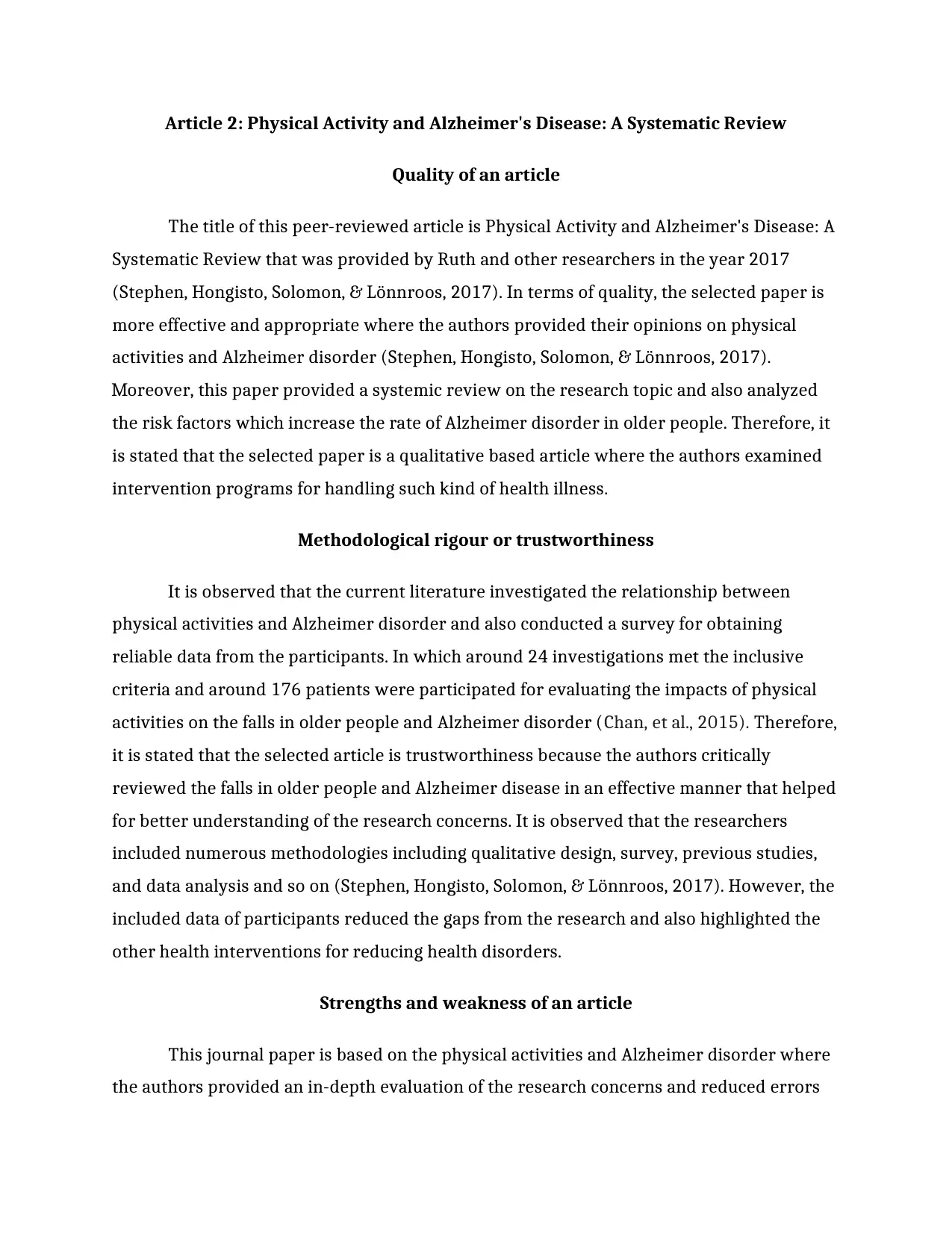
Article 2: Physical Activity and Alzheimer's Disease: A Systematic Review
Quality of an article
The title of this peer-reviewed article is Physical Activity and Alzheimer's Disease: A
Systematic Review that was provided by Ruth and other researchers in the year 2017
(Stephen, Hongisto, Solomon, & Lönnroos, 2017). In terms of quality, the selected paper is
more effective and appropriate where the authors provided their opinions on physical
activities and Alzheimer disorder (Stephen, Hongisto, Solomon, & Lönnroos, 2017).
Moreover, this paper provided a systemic review on the research topic and also analyzed
the risk factors which increase the rate of Alzheimer disorder in older people. Therefore, it
is stated that the selected paper is a qualitative based article where the authors examined
intervention programs for handling such kind of health illness.
Methodological rigour or trustworthiness
It is observed that the current literature investigated the relationship between
physical activities and Alzheimer disorder and also conducted a survey for obtaining
reliable data from the participants. In which around 24 investigations met the inclusive
criteria and around 176 patients were participated for evaluating the impacts of physical
activities on the falls in older people and Alzheimer disorder (Chan, et al., 2015). Therefore,
it is stated that the selected article is trustworthiness because the authors critically
reviewed the falls in older people and Alzheimer disease in an effective manner that helped
for better understanding of the research concerns. It is observed that the researchers
included numerous methodologies including qualitative design, survey, previous studies,
and data analysis and so on (Stephen, Hongisto, Solomon, & Lönnroos, 2017). However, the
included data of participants reduced the gaps from the research and also highlighted the
other health interventions for reducing health disorders.
Strengths and weakness of an article
This journal paper is based on the physical activities and Alzheimer disorder where
the authors provided an in-depth evaluation of the research concerns and reduced errors
Quality of an article
The title of this peer-reviewed article is Physical Activity and Alzheimer's Disease: A
Systematic Review that was provided by Ruth and other researchers in the year 2017
(Stephen, Hongisto, Solomon, & Lönnroos, 2017). In terms of quality, the selected paper is
more effective and appropriate where the authors provided their opinions on physical
activities and Alzheimer disorder (Stephen, Hongisto, Solomon, & Lönnroos, 2017).
Moreover, this paper provided a systemic review on the research topic and also analyzed
the risk factors which increase the rate of Alzheimer disorder in older people. Therefore, it
is stated that the selected paper is a qualitative based article where the authors examined
intervention programs for handling such kind of health illness.
Methodological rigour or trustworthiness
It is observed that the current literature investigated the relationship between
physical activities and Alzheimer disorder and also conducted a survey for obtaining
reliable data from the participants. In which around 24 investigations met the inclusive
criteria and around 176 patients were participated for evaluating the impacts of physical
activities on the falls in older people and Alzheimer disorder (Chan, et al., 2015). Therefore,
it is stated that the selected article is trustworthiness because the authors critically
reviewed the falls in older people and Alzheimer disease in an effective manner that helped
for better understanding of the research concerns. It is observed that the researchers
included numerous methodologies including qualitative design, survey, previous studies,
and data analysis and so on (Stephen, Hongisto, Solomon, & Lönnroos, 2017). However, the
included data of participants reduced the gaps from the research and also highlighted the
other health interventions for reducing health disorders.
Strengths and weakness of an article
This journal paper is based on the physical activities and Alzheimer disorder where
the authors provided an in-depth evaluation of the research concerns and reduced errors
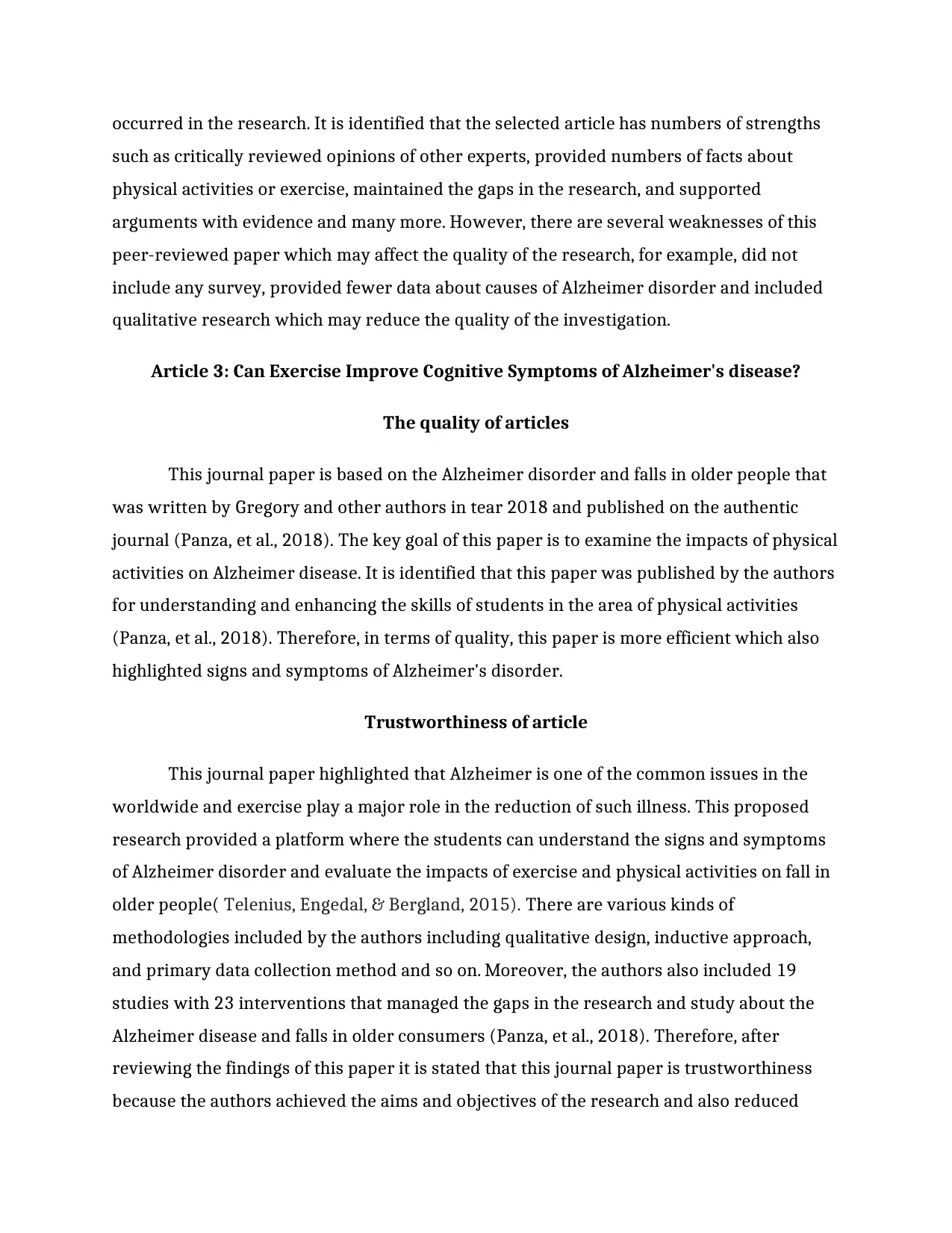
occurred in the research. It is identified that the selected article has numbers of strengths
such as critically reviewed opinions of other experts, provided numbers of facts about
physical activities or exercise, maintained the gaps in the research, and supported
arguments with evidence and many more. However, there are several weaknesses of this
peer-reviewed paper which may affect the quality of the research, for example, did not
include any survey, provided fewer data about causes of Alzheimer disorder and included
qualitative research which may reduce the quality of the investigation.
Article 3: Can Exercise Improve Cognitive Symptoms of Alzheimer's disease?
The quality of articles
This journal paper is based on the Alzheimer disorder and falls in older people that
was written by Gregory and other authors in tear 2018 and published on the authentic
journal (Panza, et al., 2018). The key goal of this paper is to examine the impacts of physical
activities on Alzheimer disease. It is identified that this paper was published by the authors
for understanding and enhancing the skills of students in the area of physical activities
(Panza, et al., 2018). Therefore, in terms of quality, this paper is more efficient which also
highlighted signs and symptoms of Alzheimer's disorder.
Trustworthiness of article
This journal paper highlighted that Alzheimer is one of the common issues in the
worldwide and exercise play a major role in the reduction of such illness. This proposed
research provided a platform where the students can understand the signs and symptoms
of Alzheimer disorder and evaluate the impacts of exercise and physical activities on fall in
older people( Telenius, Engedal, & Bergland, 2015). There are various kinds of
methodologies included by the authors including qualitative design, inductive approach,
and primary data collection method and so on. Moreover, the authors also included 19
studies with 23 interventions that managed the gaps in the research and study about the
Alzheimer disease and falls in older consumers (Panza, et al., 2018). Therefore, after
reviewing the findings of this paper it is stated that this journal paper is trustworthiness
because the authors achieved the aims and objectives of the research and also reduced
such as critically reviewed opinions of other experts, provided numbers of facts about
physical activities or exercise, maintained the gaps in the research, and supported
arguments with evidence and many more. However, there are several weaknesses of this
peer-reviewed paper which may affect the quality of the research, for example, did not
include any survey, provided fewer data about causes of Alzheimer disorder and included
qualitative research which may reduce the quality of the investigation.
Article 3: Can Exercise Improve Cognitive Symptoms of Alzheimer's disease?
The quality of articles
This journal paper is based on the Alzheimer disorder and falls in older people that
was written by Gregory and other authors in tear 2018 and published on the authentic
journal (Panza, et al., 2018). The key goal of this paper is to examine the impacts of physical
activities on Alzheimer disease. It is identified that this paper was published by the authors
for understanding and enhancing the skills of students in the area of physical activities
(Panza, et al., 2018). Therefore, in terms of quality, this paper is more efficient which also
highlighted signs and symptoms of Alzheimer's disorder.
Trustworthiness of article
This journal paper highlighted that Alzheimer is one of the common issues in the
worldwide and exercise play a major role in the reduction of such illness. This proposed
research provided a platform where the students can understand the signs and symptoms
of Alzheimer disorder and evaluate the impacts of exercise and physical activities on fall in
older people( Telenius, Engedal, & Bergland, 2015). There are various kinds of
methodologies included by the authors including qualitative design, inductive approach,
and primary data collection method and so on. Moreover, the authors also included 19
studies with 23 interventions that managed the gaps in the research and study about the
Alzheimer disease and falls in older consumers (Panza, et al., 2018). Therefore, after
reviewing the findings of this paper it is stated that this journal paper is trustworthiness
because the authors achieved the aims and objectives of the research and also reduced
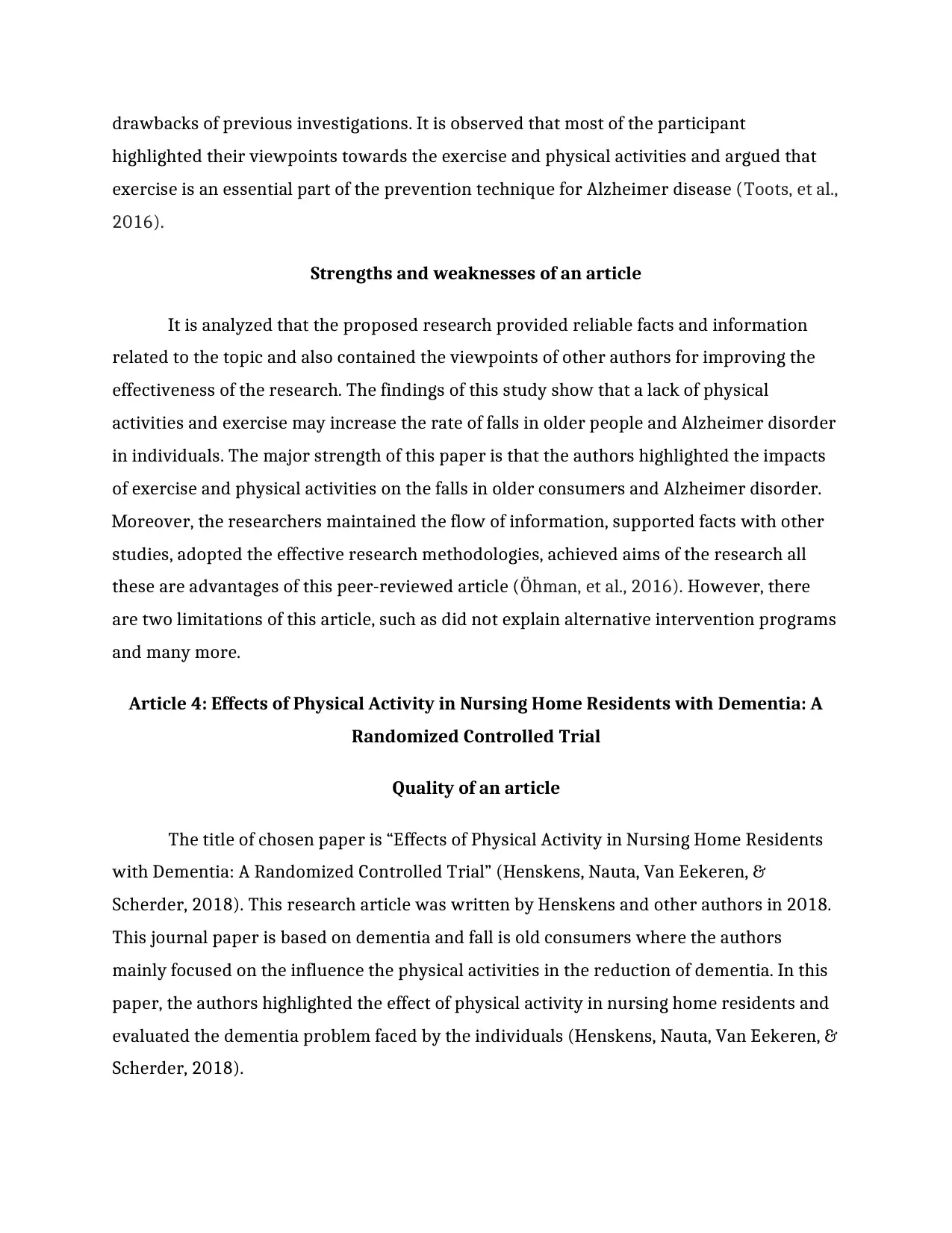
drawbacks of previous investigations. It is observed that most of the participant
highlighted their viewpoints towards the exercise and physical activities and argued that
exercise is an essential part of the prevention technique for Alzheimer disease (Toots, et al.,
2016).
Strengths and weaknesses of an article
It is analyzed that the proposed research provided reliable facts and information
related to the topic and also contained the viewpoints of other authors for improving the
effectiveness of the research. The findings of this study show that a lack of physical
activities and exercise may increase the rate of falls in older people and Alzheimer disorder
in individuals. The major strength of this paper is that the authors highlighted the impacts
of exercise and physical activities on the falls in older consumers and Alzheimer disorder.
Moreover, the researchers maintained the flow of information, supported facts with other
studies, adopted the effective research methodologies, achieved aims of the research all
these are advantages of this peer-reviewed article (Öhman, et al., 2016). However, there
are two limitations of this article, such as did not explain alternative intervention programs
and many more.
Article 4: Effects of Physical Activity in Nursing Home Residents with Dementia: A
Randomized Controlled Trial
Quality of an article
The title of chosen paper is “Effects of Physical Activity in Nursing Home Residents
with Dementia: A Randomized Controlled Trial” (Henskens, Nauta, Van Eekeren, &
Scherder, 2018). This research article was written by Henskens and other authors in 2018.
This journal paper is based on dementia and fall is old consumers where the authors
mainly focused on the influence the physical activities in the reduction of dementia. In this
paper, the authors highlighted the effect of physical activity in nursing home residents and
evaluated the dementia problem faced by the individuals (Henskens, Nauta, Van Eekeren, &
Scherder, 2018).
highlighted their viewpoints towards the exercise and physical activities and argued that
exercise is an essential part of the prevention technique for Alzheimer disease (Toots, et al.,
2016).
Strengths and weaknesses of an article
It is analyzed that the proposed research provided reliable facts and information
related to the topic and also contained the viewpoints of other authors for improving the
effectiveness of the research. The findings of this study show that a lack of physical
activities and exercise may increase the rate of falls in older people and Alzheimer disorder
in individuals. The major strength of this paper is that the authors highlighted the impacts
of exercise and physical activities on the falls in older consumers and Alzheimer disorder.
Moreover, the researchers maintained the flow of information, supported facts with other
studies, adopted the effective research methodologies, achieved aims of the research all
these are advantages of this peer-reviewed article (Öhman, et al., 2016). However, there
are two limitations of this article, such as did not explain alternative intervention programs
and many more.
Article 4: Effects of Physical Activity in Nursing Home Residents with Dementia: A
Randomized Controlled Trial
Quality of an article
The title of chosen paper is “Effects of Physical Activity in Nursing Home Residents
with Dementia: A Randomized Controlled Trial” (Henskens, Nauta, Van Eekeren, &
Scherder, 2018). This research article was written by Henskens and other authors in 2018.
This journal paper is based on dementia and fall is old consumers where the authors
mainly focused on the influence the physical activities in the reduction of dementia. In this
paper, the authors highlighted the effect of physical activity in nursing home residents and
evaluated the dementia problem faced by the individuals (Henskens, Nauta, Van Eekeren, &
Scherder, 2018).
Paraphrase This Document
Need a fresh take? Get an instant paraphrase of this document with our AI Paraphraser
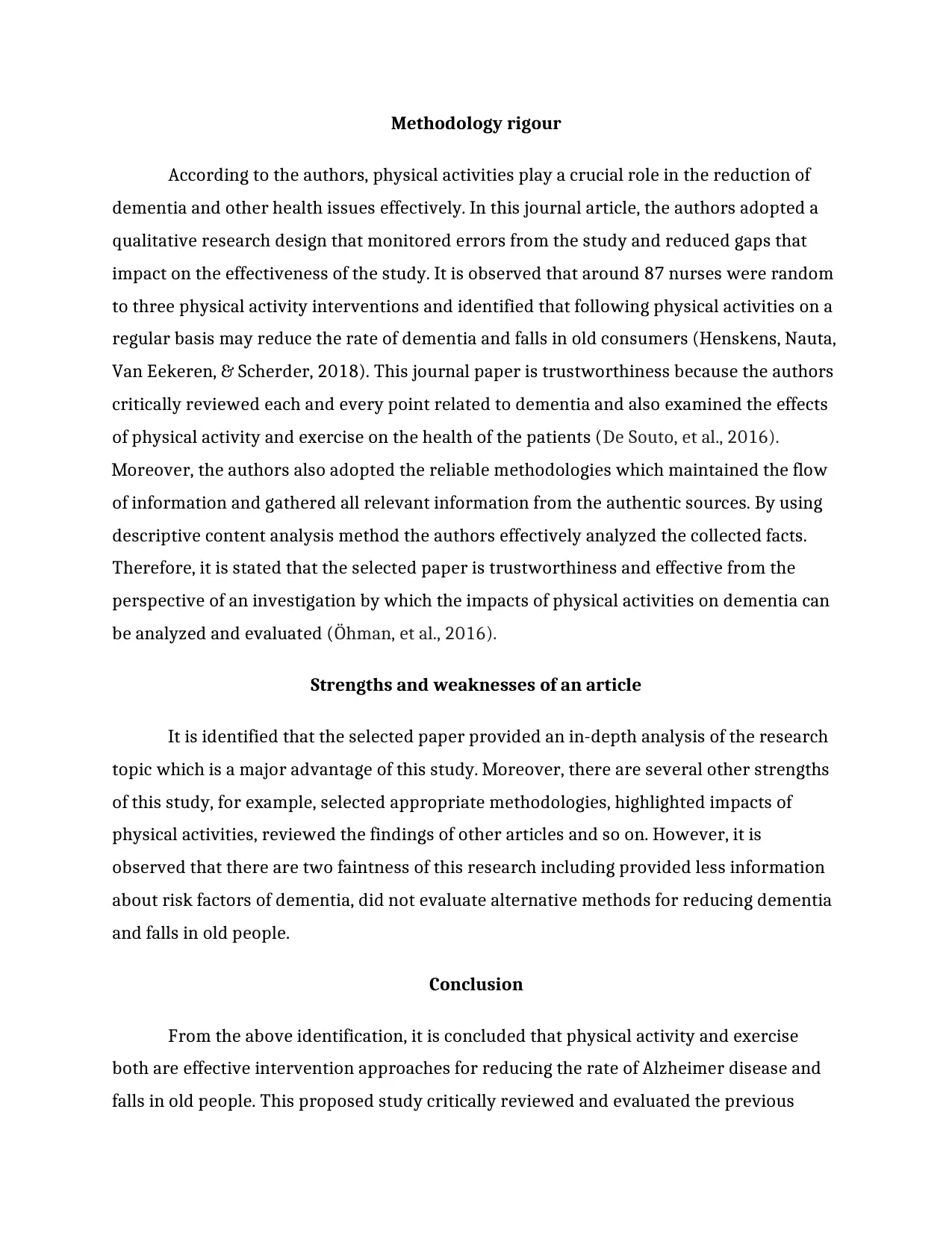
Methodology rigour
According to the authors, physical activities play a crucial role in the reduction of
dementia and other health issues effectively. In this journal article, the authors adopted a
qualitative research design that monitored errors from the study and reduced gaps that
impact on the effectiveness of the study. It is observed that around 87 nurses were random
to three physical activity interventions and identified that following physical activities on a
regular basis may reduce the rate of dementia and falls in old consumers (Henskens, Nauta,
Van Eekeren, & Scherder, 2018). This journal paper is trustworthiness because the authors
critically reviewed each and every point related to dementia and also examined the effects
of physical activity and exercise on the health of the patients (De Souto, et al., 2016).
Moreover, the authors also adopted the reliable methodologies which maintained the flow
of information and gathered all relevant information from the authentic sources. By using
descriptive content analysis method the authors effectively analyzed the collected facts.
Therefore, it is stated that the selected paper is trustworthiness and effective from the
perspective of an investigation by which the impacts of physical activities on dementia can
be analyzed and evaluated (Öhman, et al., 2016).
Strengths and weaknesses of an article
It is identified that the selected paper provided an in-depth analysis of the research
topic which is a major advantage of this study. Moreover, there are several other strengths
of this study, for example, selected appropriate methodologies, highlighted impacts of
physical activities, reviewed the findings of other articles and so on. However, it is
observed that there are two faintness of this research including provided less information
about risk factors of dementia, did not evaluate alternative methods for reducing dementia
and falls in old people.
Conclusion
From the above identification, it is concluded that physical activity and exercise
both are effective intervention approaches for reducing the rate of Alzheimer disease and
falls in old people. This proposed study critically reviewed and evaluated the previous
According to the authors, physical activities play a crucial role in the reduction of
dementia and other health issues effectively. In this journal article, the authors adopted a
qualitative research design that monitored errors from the study and reduced gaps that
impact on the effectiveness of the study. It is observed that around 87 nurses were random
to three physical activity interventions and identified that following physical activities on a
regular basis may reduce the rate of dementia and falls in old consumers (Henskens, Nauta,
Van Eekeren, & Scherder, 2018). This journal paper is trustworthiness because the authors
critically reviewed each and every point related to dementia and also examined the effects
of physical activity and exercise on the health of the patients (De Souto, et al., 2016).
Moreover, the authors also adopted the reliable methodologies which maintained the flow
of information and gathered all relevant information from the authentic sources. By using
descriptive content analysis method the authors effectively analyzed the collected facts.
Therefore, it is stated that the selected paper is trustworthiness and effective from the
perspective of an investigation by which the impacts of physical activities on dementia can
be analyzed and evaluated (Öhman, et al., 2016).
Strengths and weaknesses of an article
It is identified that the selected paper provided an in-depth analysis of the research
topic which is a major advantage of this study. Moreover, there are several other strengths
of this study, for example, selected appropriate methodologies, highlighted impacts of
physical activities, reviewed the findings of other articles and so on. However, it is
observed that there are two faintness of this research including provided less information
about risk factors of dementia, did not evaluate alternative methods for reducing dementia
and falls in old people.
Conclusion
From the above identification, it is concluded that physical activity and exercise
both are effective intervention approaches for reducing the rate of Alzheimer disease and
falls in old people. This proposed study critically reviewed and evaluated the previous
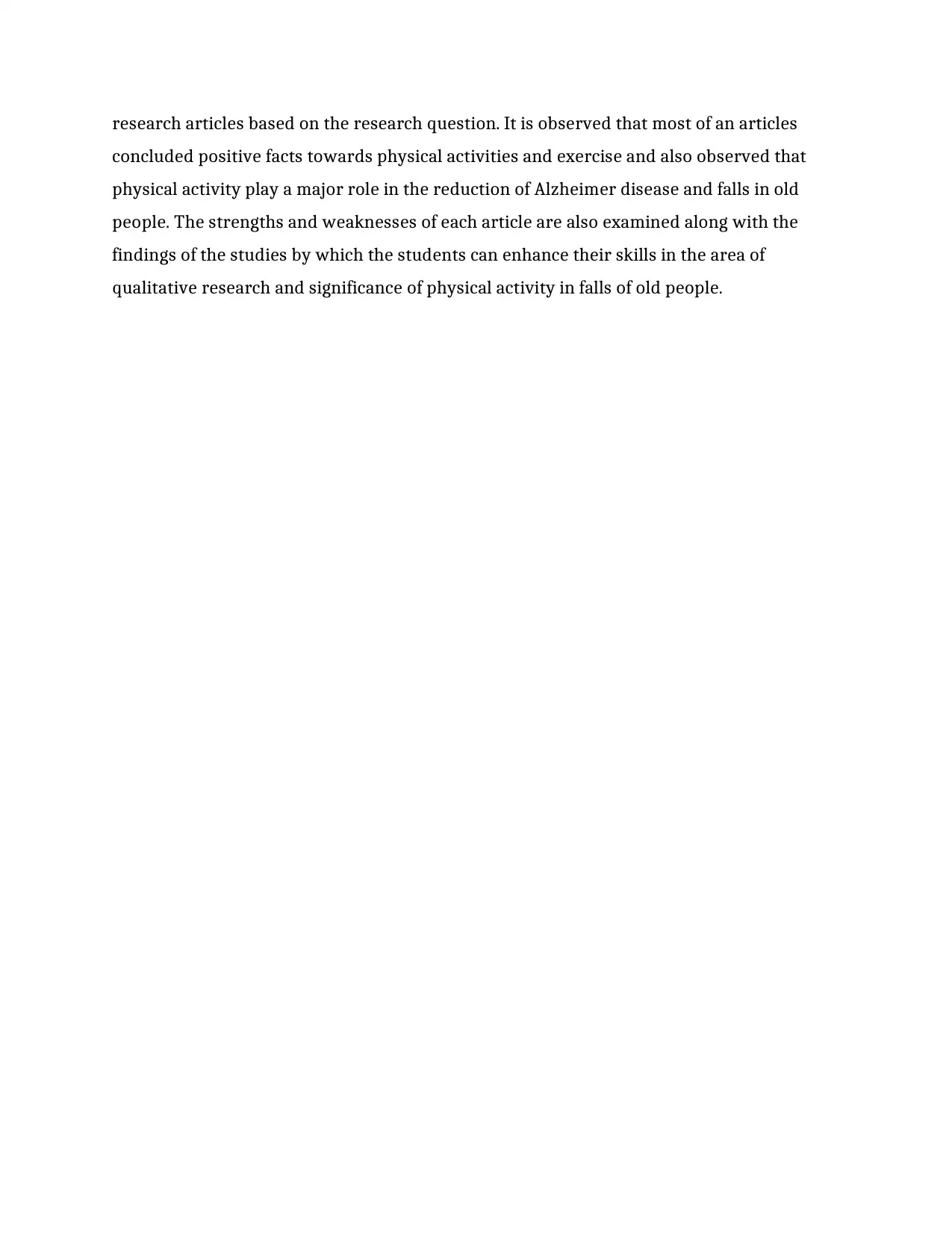
research articles based on the research question. It is observed that most of an articles
concluded positive facts towards physical activities and exercise and also observed that
physical activity play a major role in the reduction of Alzheimer disease and falls in old
people. The strengths and weaknesses of each article are also examined along with the
findings of the studies by which the students can enhance their skills in the area of
qualitative research and significance of physical activity in falls of old people.
concluded positive facts towards physical activities and exercise and also observed that
physical activity play a major role in the reduction of Alzheimer disease and falls in old
people. The strengths and weaknesses of each article are also examined along with the
findings of the studies by which the students can enhance their skills in the area of
qualitative research and significance of physical activity in falls of old people.
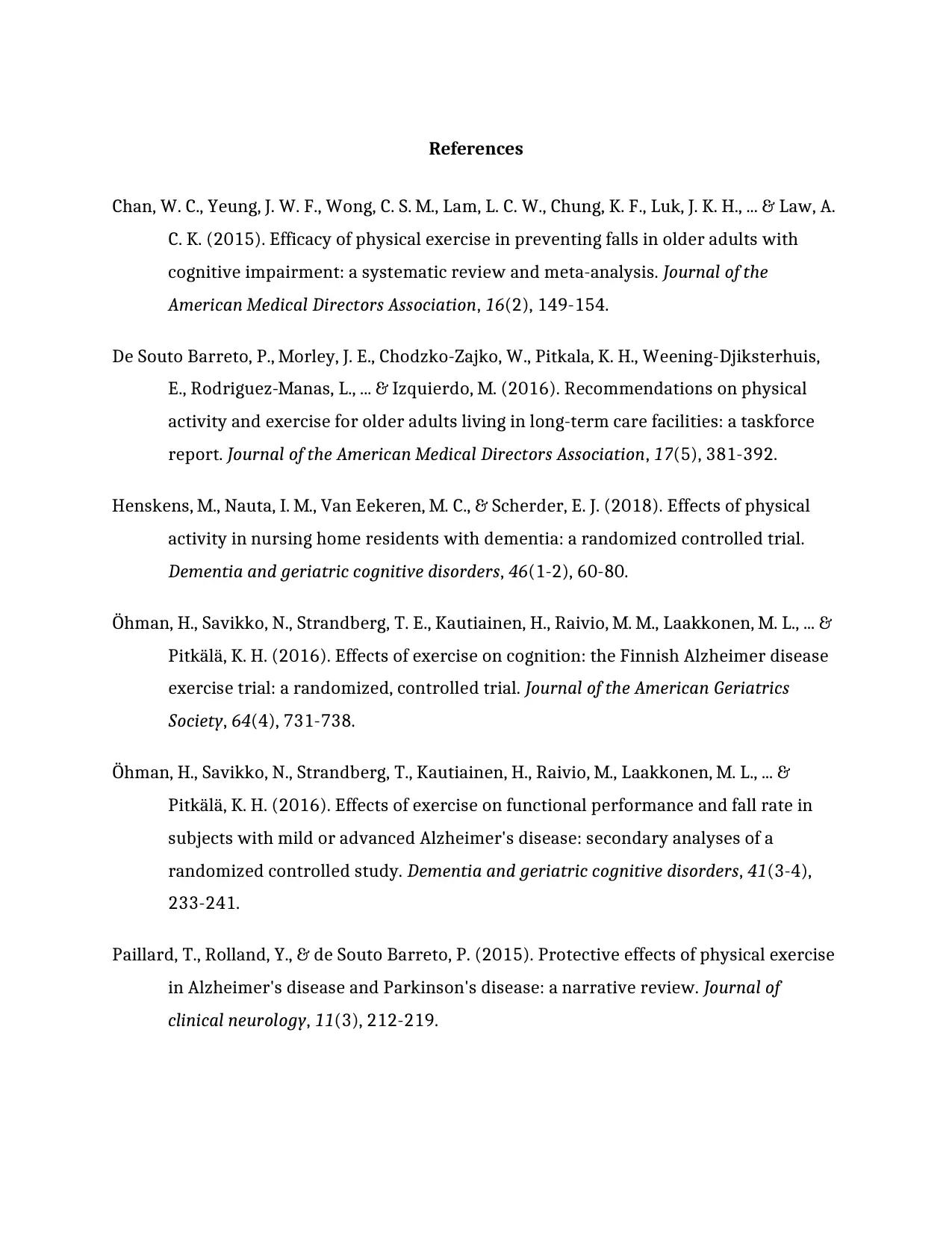
References
Chan, W. C., Yeung, J. W. F., Wong, C. S. M., Lam, L. C. W., Chung, K. F., Luk, J. K. H., ... & Law, A.
C. K. (2015). Efficacy of physical exercise in preventing falls in older adults with
cognitive impairment: a systematic review and meta-analysis. Journal of the
American Medical Directors Association, 16(2), 149-154.
De Souto Barreto, P., Morley, J. E., Chodzko-Zajko, W., Pitkala, K. H., Weening-Djiksterhuis,
E., Rodriguez-Manas, L., ... & Izquierdo, M. (2016). Recommendations on physical
activity and exercise for older adults living in long-term care facilities: a taskforce
report. Journal of the American Medical Directors Association, 17(5), 381-392.
Henskens, M., Nauta, I. M., Van Eekeren, M. C., & Scherder, E. J. (2018). Effects of physical
activity in nursing home residents with dementia: a randomized controlled trial.
Dementia and geriatric cognitive disorders, 46(1-2), 60-80.
Öhman, H., Savikko, N., Strandberg, T. E., Kautiainen, H., Raivio, M. M., Laakkonen, M. L., ... &
Pitkälä, K. H. (2016). Effects of exercise on cognition: the Finnish Alzheimer disease
exercise trial: a randomized, controlled trial. Journal of the American Geriatrics
Society, 64(4), 731-738.
Öhman, H., Savikko, N., Strandberg, T., Kautiainen, H., Raivio, M., Laakkonen, M. L., ... &
Pitkälä, K. H. (2016). Effects of exercise on functional performance and fall rate in
subjects with mild or advanced Alzheimer's disease: secondary analyses of a
randomized controlled study. Dementia and geriatric cognitive disorders, 41(3-4),
233-241.
Paillard, T., Rolland, Y., & de Souto Barreto, P. (2015). Protective effects of physical exercise
in Alzheimer's disease and Parkinson's disease: a narrative review. Journal of
clinical neurology, 11(3), 212-219.
Chan, W. C., Yeung, J. W. F., Wong, C. S. M., Lam, L. C. W., Chung, K. F., Luk, J. K. H., ... & Law, A.
C. K. (2015). Efficacy of physical exercise in preventing falls in older adults with
cognitive impairment: a systematic review and meta-analysis. Journal of the
American Medical Directors Association, 16(2), 149-154.
De Souto Barreto, P., Morley, J. E., Chodzko-Zajko, W., Pitkala, K. H., Weening-Djiksterhuis,
E., Rodriguez-Manas, L., ... & Izquierdo, M. (2016). Recommendations on physical
activity and exercise for older adults living in long-term care facilities: a taskforce
report. Journal of the American Medical Directors Association, 17(5), 381-392.
Henskens, M., Nauta, I. M., Van Eekeren, M. C., & Scherder, E. J. (2018). Effects of physical
activity in nursing home residents with dementia: a randomized controlled trial.
Dementia and geriatric cognitive disorders, 46(1-2), 60-80.
Öhman, H., Savikko, N., Strandberg, T. E., Kautiainen, H., Raivio, M. M., Laakkonen, M. L., ... &
Pitkälä, K. H. (2016). Effects of exercise on cognition: the Finnish Alzheimer disease
exercise trial: a randomized, controlled trial. Journal of the American Geriatrics
Society, 64(4), 731-738.
Öhman, H., Savikko, N., Strandberg, T., Kautiainen, H., Raivio, M., Laakkonen, M. L., ... &
Pitkälä, K. H. (2016). Effects of exercise on functional performance and fall rate in
subjects with mild or advanced Alzheimer's disease: secondary analyses of a
randomized controlled study. Dementia and geriatric cognitive disorders, 41(3-4),
233-241.
Paillard, T., Rolland, Y., & de Souto Barreto, P. (2015). Protective effects of physical exercise
in Alzheimer's disease and Parkinson's disease: a narrative review. Journal of
clinical neurology, 11(3), 212-219.
Secure Best Marks with AI Grader
Need help grading? Try our AI Grader for instant feedback on your assignments.
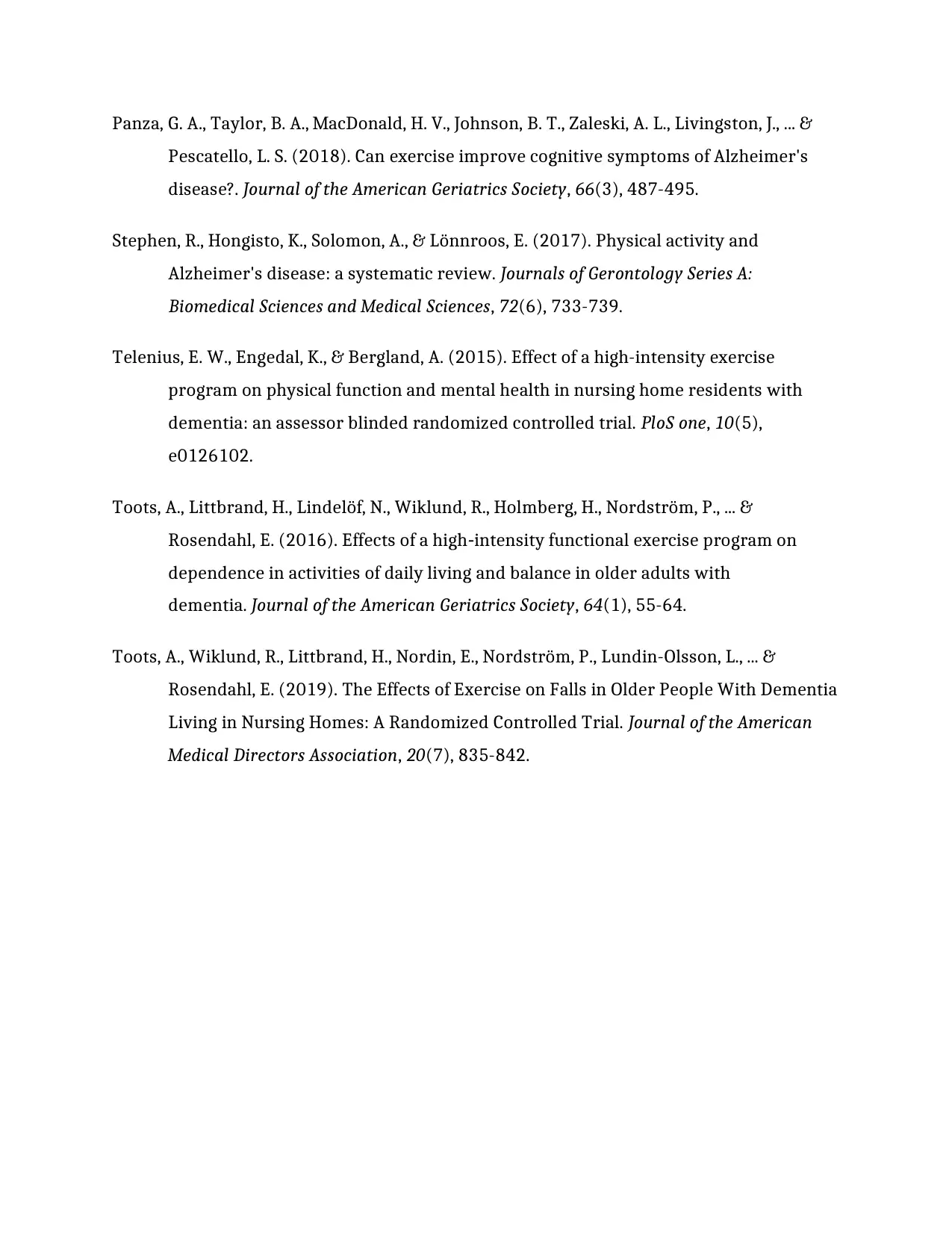
Panza, G. A., Taylor, B. A., MacDonald, H. V., Johnson, B. T., Zaleski, A. L., Livingston, J., ... &
Pescatello, L. S. (2018). Can exercise improve cognitive symptoms of Alzheimer's
disease?. Journal of the American Geriatrics Society, 66(3), 487-495.
Stephen, R., Hongisto, K., Solomon, A., & Lönnroos, E. (2017). Physical activity and
Alzheimer's disease: a systematic review. Journals of Gerontology Series A:
Biomedical Sciences and Medical Sciences, 72(6), 733-739.
Telenius, E. W., Engedal, K., & Bergland, A. (2015). Effect of a high-intensity exercise
program on physical function and mental health in nursing home residents with
dementia: an assessor blinded randomized controlled trial. PloS one, 10(5),
e0126102.
Toots, A., Littbrand, H., Lindelöf, N., Wiklund, R., Holmberg, H., Nordström, P., ... &
Rosendahl, E. (2016). Effects of a high‐intensity functional exercise program on
dependence in activities of daily living and balance in older adults with
dementia. Journal of the American Geriatrics Society, 64(1), 55-64.
Toots, A., Wiklund, R., Littbrand, H., Nordin, E., Nordström, P., Lundin-Olsson, L., ... &
Rosendahl, E. (2019). The Effects of Exercise on Falls in Older People With Dementia
Living in Nursing Homes: A Randomized Controlled Trial. Journal of the American
Medical Directors Association, 20(7), 835-842.
Pescatello, L. S. (2018). Can exercise improve cognitive symptoms of Alzheimer's
disease?. Journal of the American Geriatrics Society, 66(3), 487-495.
Stephen, R., Hongisto, K., Solomon, A., & Lönnroos, E. (2017). Physical activity and
Alzheimer's disease: a systematic review. Journals of Gerontology Series A:
Biomedical Sciences and Medical Sciences, 72(6), 733-739.
Telenius, E. W., Engedal, K., & Bergland, A. (2015). Effect of a high-intensity exercise
program on physical function and mental health in nursing home residents with
dementia: an assessor blinded randomized controlled trial. PloS one, 10(5),
e0126102.
Toots, A., Littbrand, H., Lindelöf, N., Wiklund, R., Holmberg, H., Nordström, P., ... &
Rosendahl, E. (2016). Effects of a high‐intensity functional exercise program on
dependence in activities of daily living and balance in older adults with
dementia. Journal of the American Geriatrics Society, 64(1), 55-64.
Toots, A., Wiklund, R., Littbrand, H., Nordin, E., Nordström, P., Lundin-Olsson, L., ... &
Rosendahl, E. (2019). The Effects of Exercise on Falls in Older People With Dementia
Living in Nursing Homes: A Randomized Controlled Trial. Journal of the American
Medical Directors Association, 20(7), 835-842.
1 out of 11
Related Documents
Your All-in-One AI-Powered Toolkit for Academic Success.
+13062052269
info@desklib.com
Available 24*7 on WhatsApp / Email
![[object Object]](/_next/static/media/star-bottom.7253800d.svg)
Unlock your academic potential
© 2024 | Zucol Services PVT LTD | All rights reserved.





